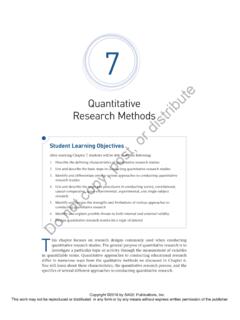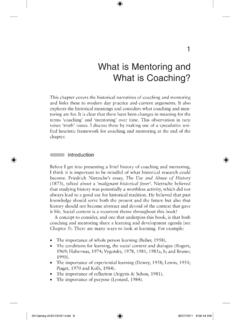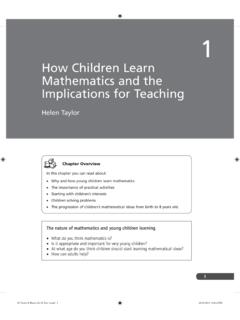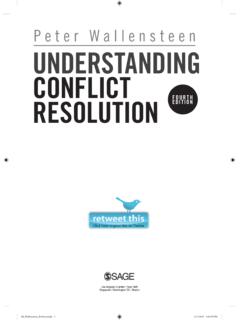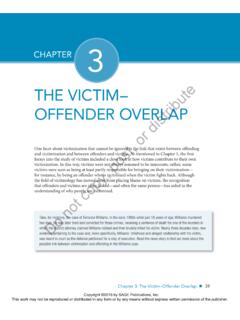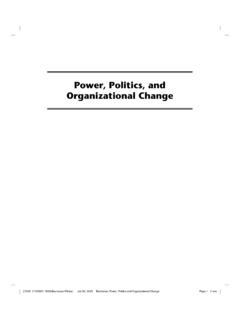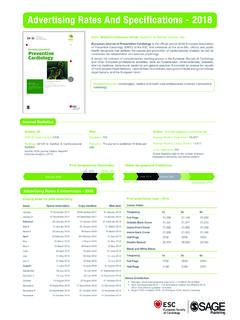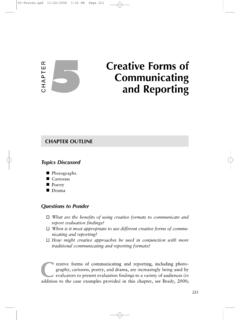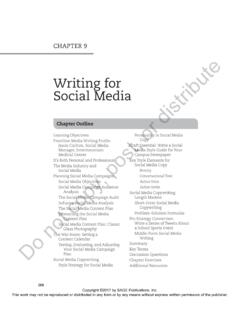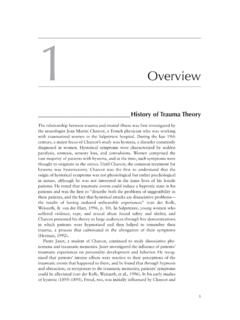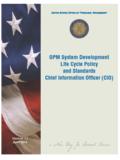Transcription of CHAPTER 3 Conducting a Literature Review
1 62 CHAPTER3 Learning ObjectivesAfter finishing this CHAPTER , you should be able Summarize what a Literature Review is, what it tells the reader, and why it is Evaluate the nine basic steps taken to write a well-constructed Literature Conduct an electronic search using terms, phrases, Boolean operators, and Evaluate and identify the parts of an empirical research journal article, and use that knowledge to summarize a piece of Identify and summarize the organizational approaches and writing strategy elements of MEAL that are useful when Conducting a Literature Demonstrate an understanding of the ethics involved and the common pitfalls associated with writing a Literature a Literature ReviewIntroductionWith a research question in hand, you are ready to conduct a Literature Review .
2 This CHAPTER provides the information needed to write a quality academic Literature Review . Although it is widely recognized that many students fear statistics, less acknowledged is that the fear, loathing, and dread of writing a Literature Review is equally if not more common. This appre-hension should not be surprising. As Rachel Boba Santos, one of our featured researchers, notes, [w]riting a Literature Review is easy with the right skills. In general, students have not learned how to write them, but when taught skills, they can do it well.
3 This CHAPTER offers those learning the skills needed to write a Literature Review , we want to acknowledge some realities about litera-ture reviews. First, people frequently are not taught the skills needed to write a Literature Review . Writing a Literature Review is not instinctive, so without these skills, students are con-fused and stressed, and professors frequently are disappointed with the resulting work. Second, why you or other researchers need a Literature Review is rarely discussed, or when it is, it is quickly glossed over.
4 With a full understanding about the purpose of a Literature Review , people are better able to accom-plish them. Third, what a Literature entails is rarely explicated. Too frequently, someone is expected to write a Literature Review when what is involved in constructing a Literature Review has not been explained to them. Fourth, clearly outlining the steps taken to construct a Literature Review is frequently incomplete or not provided at all. In short, why a Literature Review is needed, what a Literature Review is, and how to write one too frequently receive little, if any, attention in research methods texts.
5 That is not the case in this book where we devote a full CHAPTER to this important CHAPTER begins by identifying why a Literature Review is important, and it clearly describes what a Literature is. The CHAPTER then offers concrete steps taken to construct a Literature Review including identifying what sources are needed, how to find the sources, a systematic method to summarize and synthesize the sources, and organizational and writing strat-egies to produce an excellent Literature Review . Finally, pitfalls Copyright 2019 by SAGE Publications, Inc.
6 This work may not be reproduced or distributed in any form or by any means without express written permission of the not copy, post, or distributeChapter 3 | Conducting a Literature Review 63commonly found in Literature reviews, as well as ethical considerations in the construction of a Literature Review , are discussed. The CHAPTER closes with a discussion with Sean McCandless, PhD, an expert Literature Review writer, about best practices, common errors, and what makes Literature reviews Conduct a Literature Review ?A Literature Review is an important part of research that serves many purposes.
7 Consider how our featured researchers responded to Why is a Literature Review important? Santos notes that [t]he pur-pose of Literature Review is to tell the story of what is known about the topic and identify the strengths and weaknesses of that knowledge, including gaps our understanding. Gaps can be as simple as while there is a good study done, it is the only study done on this topic. Carlos Cuevas stresses that [a] Literature Review lets the world know you have a clue on what you are talking about. It also provides the means to sell the research proposed.
8 It offers an oppor-tunity to make the argument as to why the research I want to do is important. Rod Brunson contends, A Literature Review situates the current study into the broader body of scholarship. It provides an understanding of related research that has been done, the populations research has focused on, and the context of prior studies. This highlights the contribution of the pro-posed study. Given these valuable reasons to conduct a Literature Review , it is not surprising that Brunson states that, while you can technically conduct research without Conducting a Literature Review , you really shouldn t.
9 It makes no sense to do so you may be planning on Conducting a study that has been done, and this is something you could discover easily with a Literature Review . A Literature Review presents an understanding, or a snapshot, of the overall state of the Literature by surveying, summarizing, and synthesizing existing Literature about the topic of interest. A well-constructed Literature Review identifies major themes associated with a topic, and it demonstrates where there is agreement, and disagreement, about that topic. The Review identifies limitations of prior research, and it exposes gaps in our understanding about a topic, which indicate possible directions of future inquiry on the topic.
10 A well-constructed Literature Review should situate the proposed research in the context of extant Literature , and it should clearly identify how the proposed research will create new knowledge that enhances the existing knowledge about the topic. If a research question is the guardrails of our research, the Literature Review is the pavement on which we are traveling. Understanding what we know about a topic is critical to ensuring the research whether done as a student at the university or during your career increases our Road Map: How to Conduct a Literature ReviewThis CHAPTER describes the steps taken to conduct a Literature Review .
